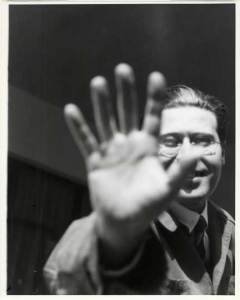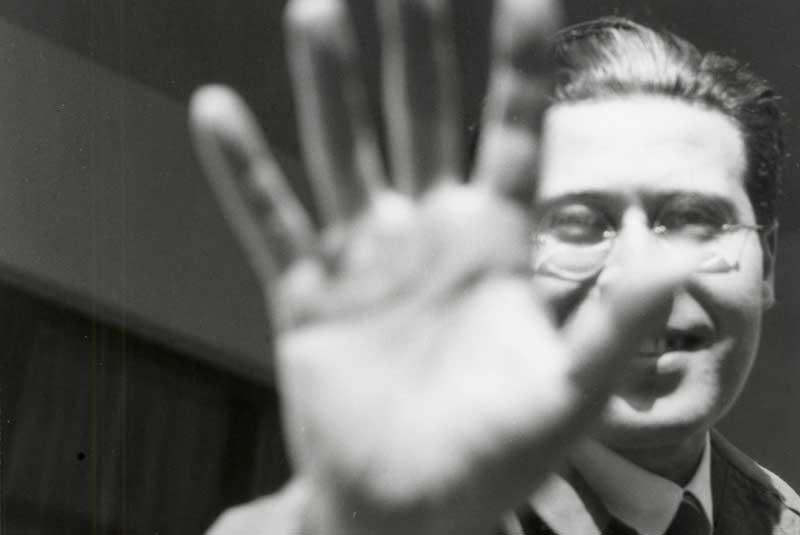Contemporary artists are everywhere in museums these days. From Yinka Shonibare to Grayson Perry, Jeremy Deller to Mark Wallinger, contemporary works bring new perspectives and angles to old collections. They are seen as roughing up the establishment a little, asking awkward or playful questions of traditional objects, thinking outside the box.

Portrait of László Moholy-Nagy (1926), photo by Lucia Moholy. Photo Credit: Bauhaus-Archiv Berlin © VG Bild-Kunst, Bonn 2014
It seems increasingly that an artist’s perspective can provide precisely the individual, alternative or celebrity voices that museums themselves want, along with different types of experiences and spaces. But a recent visit to the Bauhaus Archive and Museum of Design in Berlin also showed me that these ideas are nothing new. Bauhaus artist László Moholy-Nagy was, in fact, forging a path that most modern museums would envy as early as the 1920s.
‘Sensing the Future: Moholy-Nagy, Media and the Arts’ argues for the artist as a pioneering thinker, who foresaw many of our current debates about digital culture and the relationship between people and technology. Moholy-Nagy thought people needed help in managing an explosion of media, and his experimental responses to these concerns reflect, I think, precisely the kinds of ways in which European museums are dealing with the challenges posed to material collections by ever-expanding digital possibilities.

Kinetic-constructive system. Structure with movement tracks for play and conveyance (1928), László Moholy-Nagy. Photo Credit: Theaterwissenschaftliche Sammlung, Universität zu Köln © VG Bild-Kunst, Bonn 2014
Moholy-Nagy investigated the creation of immersive spaces, in which visitors experienced artworks as a physical event. His Kinetic-Constructive System designed in the early 1920s, created a structure with different paths of motion for sport or recreation. I can easily imagine it in the Turbine Hall at Tate Modern. He imagined bare spaces filled with projections, in which sound and light worked with hanging or automated sculptures to create artworks out of shadow sequences. The exhibition includes a recreation of Moholy-Nagy’s piece Light Prop for an Electric Stage(to use the name chosen in the catalogue), in which he sought to create an immersive abstract experience. How many displays bring soundscapes and projections together with object displays today? Some of the recent special exhibitions in the British Museum’s round Reading Room, in particular, have succeeded in creating such environments.
And what about visitors with vision or hearing difficulties? How might their experience of objects and museums be improved? Moholy-Nagy researched ideas on sensory training, making tactile charts to train his students in haptic skills of material identification. He developed ‘hand sculptures’ as the pure expression of the function of making with the hand. He even experimented with introducing smell into performative artworks. In a very nice touch, the Bauhaus display uses this section to create a path through the exhibition for visually impaired visitors. Strips of flooring with a different surface guide you to an area with replica materials and sculptures to allow your own physical experience of Moholy-Nagy’s arguments.

László Moholy-Nagy at a training of bodily awareness, probably at the Feminist womens’ commune Schwarzerden (c. 1925), unknown photographer
These are, of course, replicas, and not unfittingly for the artist: Moholy-Nagy was early to recognise the complex relationship between originals and reproductions. He argued in the journal De Stijl in 1922 that reproductive technologies should and could be used to make original artworks, that these possibilities needed embracing and expanding. Just think of all the complex ways that museums negotiate reproductions today. Snowballing use of personal images on social media relies on the use of technologies that edit, filter and tag pictures to repurpose them for different users. The Rijksmuseum’s ‘Rijksstudio’ is the boldest example of how such technologies can open museum collections up, to see how they might be reproduced and adapted.
There is much else that could be said about this dense, beautiful and deftly argued exhibition, which embodies Moholy-Nagy’s immersive and sensory ideas in the display itself. It aims to introduce the artist’s pioneering ideas to a younger digital generation. It seems to me that museums could do much worse than follow his lead.
‘Sensing the Future: László Moholy-Nagy, the Media and the Arts’ is at the Bauhaus Archive/Museum of Design, Berlin, until 2 February 2015.
Related Articles
Inquiry: Attention Seekers. Museums and interactive displays (Richard Martin)
Mirrorcity: Glimpsing the digital revolution (Jessica Furseth)
Are art installations the new video games? (Danielle Thom)
Unlimited access from just $16 every 3 months
Subscribe to get unlimited and exclusive access to the top art stories, interviews and exhibition reviews.
















![Masterpiece [Re]discovery 2022. Photo: Ben Fisher Photography, courtesy of Masterpiece London](http://www.apollo-magazine.com/wp-content/uploads/2022/07/MPL2022_4263.jpg)
It’s time for the government of London to return to its rightful home